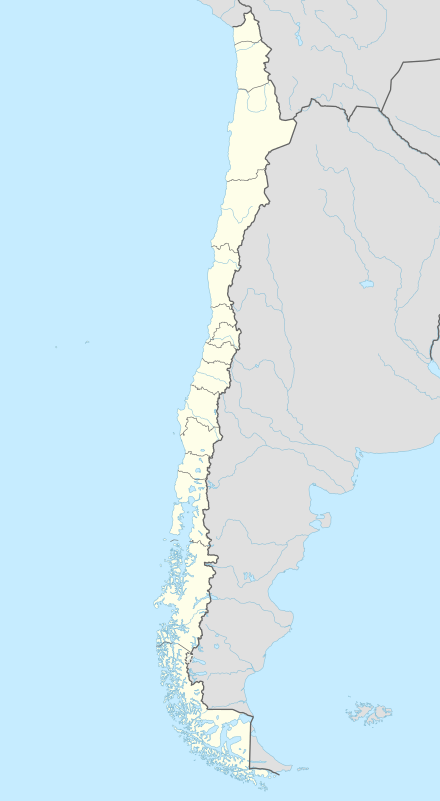Osorno Province
| Osorno Province Provincia de Osorno | ||
|---|---|---|
| Province | ||
| ||
 Location in the Los Lagos Region | ||
 Osorno Province Location in Chile | ||
| Coordinates: 40°35′S 73°10′W / 40.583°S 73.167°WCoordinates: 40°35′S 73°10′W / 40.583°S 73.167°W | ||
| Country | Chile | |
| Region | Los Lagos | |
| Capital | Osorno | |
| Communes | ||
| Government | ||
| • Type | Provincial | |
| Area[1] | ||
| • Total | 9,223.7 km2 (3,561.3 sq mi) | |
| Area rank | 3 | |
| Population (2012 census)[1] | ||
| • Total | 221,496 | |
| • Rank | 2 | |
| • Density | 24/km2 (62/sq mi) | |
| • Urban | 163,808 | |
| • Rural | 57,701 | |
| Sex[1] | ||
| • Male | 110,048 | |
| • Female | 111,461 | |
| Time zone | CLT (UTC-4) | |
| • Summer (DST) | CLT (UTC-3) | |
| Area code(s) | 56 + 64 | |
| Website | Government of Osorno | |
Osorno Province (Spanish: Provincia de Osorno) is one of the four provinces in the southern Chilean region of Los Lagos (X). The province has an area of 9,223.7 km2 (3,561 sq mi) and a population of 221,496 distributed across seven communes (Spanish: comunas). The provincial capital is the city of Osorno.
Osorno is a city located in southern Chile a territory of northern Patagonia in the Los Lagos Region. The Chilean Patagonia starts at Latitude 39° South in Valdivia and then it continues through the Chiloe Island and the fiords that continue its course south through the Pacific Ocean and the Cordillera de los Andes until it reaches Latitude 56° South at Cape Horn.The province possesses one of the most frequented mountain passes of Chile, the Cardenal Antonio Samoré Pass which links the province with Villa La Angostura and San Carlos de Bariloche in Argentina.
Administration
As a province, Osorno is a second-level administrative division, governed by a provincial governor who is apoointed by the president. The Osorno Province comprises seven communes; each commune is governed by its own municipality, headed by an alcalde.
Communes
History
The first inhabitants of the area were Huilliches indigenous people. It also highlights the German Colonization in Chile, which took place in the 19th century, when the Chilean government brought German settlers to assist in the growth of the region.
Ethnocultural demography
The Osorno province owes its legacy to fairly recent Chilean settlement, when the government subdued the region's indigenous Mapuche peoples in the mid-19th century and opened the land to Chilean and European immigration soon to follow. Large percentage of locals in Osorno are descendants of Spanish (the livestock grazing industry owes its foundation to the Basques) and other European immigrants.
In Osorno, there are historic ties and bonds with the Dutch, British esp. Scots with some Irish and English, French, Germans including Austrians and Swiss, Italians, Portuguese, ex-Yugoslavians, Greeks and from the Middle East are Arabs and Palestinians. These ethnic groups came in the late 19th century and early 20th century period.
It is thought in Central Chile (including Osorno), a small pattern of American immigration claiming to be of Cherokee Indian descent immigration occurred after the Dawes Act in the 1870s and 1880s displaced Native American farmers from Indian Territory now the state of Oklahoma, but the number of descendants is minuscule compared to the Spanish-Basque-ethnic German-Mapuche population.
Around 1850, the government of Chile began inviting German settlers to the colony to promote growth in the region; the settlers found Osorno's climate and geography to be very similar to their own. With their help, Osorno was made the home of the national cattle ranch of Chile, boosting the regional economy significantly. Present-day Osorno has preserved 19th-century architecture and urban layout, represented by six picturesque houses which have been designated national monuments.[2]
Economic activity
The main economic activity in the province is livestock, Osorno being one of the most important agricultural centers of Chile, which is identified with the slogan "Land of Milk and Meat of Chile". Another important economic activity is tourism.
Tourist attractions
The province is dominated by its great natural beauty, especially by:
- The lake and mountainous communes of Puerto Octay and Puyehue, where the German migrated influence is evident; mainly in construction and catering. The main tourist attractions in the area are its beautiful lakes: Llanquihue, Puyehue and Rupanco with multiple beaches each; Puyehue National Park (tourist centre which has the Hot spring and Baths of Puyehue and Aguas Calientes; and Antillanca ski resort).
- The communes central of Osorno and San Pablo, where Osorno city identifies itself with the slogan "City-Park of Chile". Osorno city is also notable for being the tourist centre of the province, since it serves as a nexus to go to other communes in the province.
- The coastal communes of Purranque, Rio Negro and San Juan de la Costa, presenting a wide coastal area, rich in natural resources, and ecotourism and etnotourism. This area highlights the beaches Pucatrihue and Maicolpue. Also this zone presents wildlife reserves created by the original inhabitants of ethnic Huilliche, such as the Network of Community Parks Mapu Lahual, associated with marine and coastal protected area Lafken Mapu Lahual.
External links
- (Spanish) Diario Austral de Osorno newspaper of Osorno
References
- 1 2 3 (Spanish) Instituto Nacional de Estadísticas
- ↑ Embassy of Chile, Washington, DC. "South; Araucaria, Lakes & Volcanoes". Chile. Retrieved 2007-06-06.

